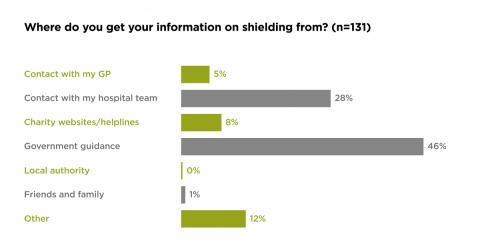Many stem cell transplant patients have been recognised as clinically vulnerable, and as such many are likely to be shielding.
Given the recent changes to the shielding guidance, alongside variation in the approach to this across the UK, shielding was a key theme for this survey. Questions were developed to help understand how confident patients feel in making decisions around shielding and what sources they are relying on for information.
94% of respondents have received a letter, text message or advice from the NHS, GP or their hospital specialist letting them know that they are clinically extremely vulnerable and need to shield.
Information about shielding

Government guidance is forming the basis of 46% of respondents’ knowledge of shielding, followed by contact with their hospital team (28%). This is despite 71% of this shielded cohort being able to contact their healthcare team as usual. Therefore, the clarity of national guidance is important as it is a key source of information for clinically vulnerable patients.
Changes to shielding guidance
I have felt unsure or concerned at the way in which measures have been relaxed or adapted, and I would feel much more comfortable if the rationale for changing guidance was explained to us.
Patient survey respondent
Given that Government guidance is the source of just under half of respondents’ information on shielding, there was a concerning level of confusion and frustration expressed by the respondents. The variation in approach across the Devolved Nations is adding to the lack of clarity about shielding, as respondents seemed unclear about which guidance they needed to follow.
Confusing and conflicting and often contradictory in terms of their press conferences. The situation is also not simplified by the fact that devolved government (here in Northern Ireland) has put forward other pathways and timelines.
Patient survey respondent
Many respondents expressed frustration with what they perceived as a dramatic change to shielding advice. They described being unclear on the evidence base for these decisions and how this interacts with their own individual risk. They described discrepancies between the Government advice and that of their medical team, or personal perception of risk. When asked what support needed to be in place to allow them to continue shielding, 43% said they would require additional support if they were to continue to shield.
The future of shielding guidance
While the shielding guidance has now been ‘paused’ in England, Wales and Northern Ireland, we strongly recommend that patients speak to their healthcare team before changing their practice.
The impact of the suspension of shielding is that it is unclear what access to practical support shielded individuals will have, and they may be expected to return to work. However, their employment rights are now unclear with no meaningful protection in place if their workplace is not COVID-19 secure and they cannot work from home.
I am particularly worried about returning to work, I am unable to work from home to undertake my role. My only option to get to work is to use public transport, and I am very worried about using public transport for the foreseeable future even if I wear all of the required PPE and practice social distancing.
Patient survey respondent
Therefore, to protect them, patients who are advised to continue shielding by their healthcare team must continue to receive the protections they need. This includes access to food, medicines and other essential supplies, as well as strong employment rights.